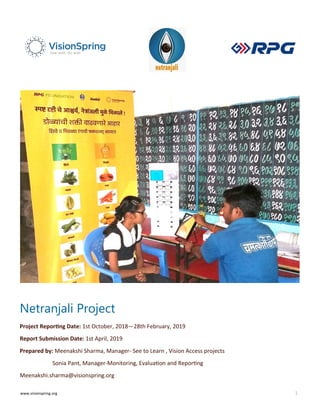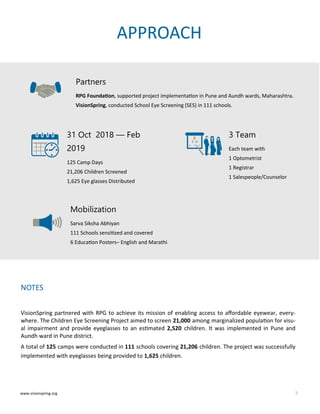Impact Of Eyeglasses On Educational Output
- 1. www.visionspring.org 1 Netranjali Project Project Reporting Date: 1st October, 2018ŌĆö28th February, 2019 Report Submission Date: 1st April, 2019 Prepared by: Meenakshi Sharma, Manager- See to Learn , Vision Access projects Sonia Pant, Manager-Monitoring, Evaluation and Reporting Meenakshi.sharma@visionspring.org
- 2. www.visionspring.org 2 EXECUTIVE SUMMARY ŌĆö final results ŌĆö ŌĆö project origin ŌĆö Netranjali is a flagship program of RPG, focuses on Preventive, Rehabilitative and Curative eye health interven- tions for school children, truckers and elderly population in slum communities. In October 2018, RPG collabo- rated with VisionSpring to serve on preventive eye care and reach out to an increased number of school chil- dren in Pune and Aundh wards in Pune, Maharashtra. The aim of the project was to screen school children for visual problems, and provide eyeglasses or refer them for further diagnosis and treatment to a tertiary care centers. STUDENTS experience the learning equivalent of an addi- tional half year of schooling2 21.2k CHILDREN SCREENED 1.6k CHILDREN IN GLASSES FIRST TIME WEARERS57% ŌĆö impact ŌĆö
- 3. www.visionspring.org 3 APPROACH NOTES VisionSpring partnered with RPG to achieve its mission of enabling access to affordable eyewear, every- where. The Children Eye Screening Project aimed to screen 21,000 among marginalized population for visu- al impairment and provide eyeglasses to an estimated 2,520 children. It was implemented in Pune and Aundh ward in Pune district. A total of 125 camps were conducted in 111 schools covering 21,206 children. The project was successfully implemented with eyeglasses being provided to 1,625 children. Mobilization Sarva Siksha Abhiyan 111 Schools sensitized and covered 6 Education PostersŌĆō English and Marathi 31 Oct 2018 ŌĆö Feb 2019 125 Camp Days 21,206 Children Screened 1,625 Eye glasses Distributed Partners RPG Foundation, supported project implementation in Pune and Aundh wards, Maharashtra. VisionSpring, conducted School Eye Screening (SES) in 111 schools. 3 Team Each team with 1 Optometrist 1 Registrar 1 Salespeople/Counselor
- 4. www.visionspring.org 4 LOCATIONS Indicator Achieved Target Percentage Achievement # of children screened 21,206 21,000 101% Eyeglasses provided to children 1,625 2,520 64% Pune and Aundh ward, Maharashtra Achievement against Target
- 5. www.visionspring.org 5 Diagnosis Eyeglasses Coverage Percentage of people who have the glasses they need, before & 21,206 Child Screenings 8% Required Glasses 99.6% Acquired Glasses 2% Re- ferred for other Eye Conditions RESULTS NOTES A total of 21,206 school children were screened from 111 schools in Pune and Aundh district of Maharashtra. Of the total children screened, 8% (n=1,632) were identified with refractive error and 2% (n=1417) with other visual disor- ders who were referred for further diagnosis to a tertiary care hospitals. This is consistent with our findings from across the country, especially in peri urban settings. Of the total children identified with refractive error 33.7% (n=550) reported use of eyeglasses. Through vision screening camp a total of 99.6% received eyeglasses. It is evident that vision screening camps in school children helps in identifying higher cases of refractive error and early vision correction through glasses in comparison to no camps (99.6% verses 33.7%) Pre-intervention Post-intervention 33.7% 99.6%% increase in glasses coverage = 66%
- 6. www.visionspring.org 6 1,625 Child Eyeglasses RESULTS Pairs by Age Group 99.6% Prescription 46% Male 53% Female 57% First Time Wear- ers $2 Glasses Price 65% 2.5% 16ŌĆö18 10ŌĆö15 5ŌĆö9 NOTES It was revealed from the data that of the total 1,632 children identified with refractive error, 1,625 children re- quired glasses. Children who received glasses majority (90%, n=1,461) falls between 10 to 15 years of age group. This project shows 57% of First time wearers (FTW) rate, this is due to peri urban settings, where some health ser- vices are available. Whereas in the rural settings where there are limited health services the FTW rate are higher as 70%. 90% 7.5%
- 7. www.visionspring.org 7 SUCCESS STORIES Age: 12 years Title: Student, 6th Standard ŌĆ£I used to find difficult to see from a distance. Things used to appear blurry, I could not even see the black board clearly. Whenever, I sit in the last row I used to make spelling mistakes, because of which I always used to sit in the front row. Since, the day I have my first pair of eyeglasses I can see the black board clearly even from the last row.ŌĆØ Shivraj Dipti Gujaria Age: 11 years Title: Student, 5th Standard ŌĆ£It was difficult to see the black board due to blurry vision. Now, I can see clearly with my first pair of eye glasses.ŌĆÖŌĆÖ
- 8. www.visionspring.org 8 LEARNINGS WAY FORWARD Moving from an alphabet chart to single letter chart to pre-screen School Children: An important aspect of pre- screening is identifying children who need full refraction by the optometrist by placing vision chart at six meters dis- tance. Since, the pilot was aimed at school children, we initially used the alphabet-based SnellenŌĆÖs chart. One of the key learnings that emerged from using this chart was that the children who were unable to recognize the character were referred for full refraction by optometrist. Our optometrists soon realized that most of these children being re- ferred to them had perfect vision and suggested we change the screening chart type from alphabet to an E or C chart, which serve the same purpose by indicating direction the letter is facing. With this change in charts, the number of children identified for the technical screenings reduced from an average of 33% to 14%, thus increasing the efficiency of our pre-screening process as well as technical camps. Awareness for Vision Services and Eyeglasses: There is less awareness for vision services, as the communities we work still donŌĆÖt consider eye care a health priority. The issues of noncompliance with wearing of eyeglasses has been a long-standing challenge in school eye health programs. These challenges can be reduced if we involve parents as vol- unteers on the day of the screening, and counsel parents, teachers, and children about the benefits of eyeglasses, their regular use and how one should take care of their glasses. Project scale up: After completing screening of 21.206 children at 111 schools in Pune, Maharashtra, RPG wants to scale up the project for 2019 and 2020. See well. Do well. THANK YOU
- 10. www.visionspring.org 10 Annexure 1: Camp report Please refer to the excel sheet attached
- 11. www.visionspring.org 11 2 Refraction 3 Glasses selection 1 Registration PHOTO GALLERY
- 12. www.visionspring.org 12 ABOUT THE PARTNERS VisionSpring VisionSpring is a pioneering, international social enterprise accelerating the uptake of affordable eyewear among people who earn less than $4 per day in emerging and frontier markets. Founded in 2001, VisionSpring uncovers latent demand for vision correction; conducts community, workplace and school vision screenings; trains others to do the same; and supplies radically affordable, durable eyeglasses. As of December 2017, Vi- sionSpring has distributed 4.4 million pairs of eyeglasses, providing vision correction in 43 countries with over 200 NGO, corporate, government and health partners. VisionSpring has been recognized for its innovative work with the Skoll Award; social entrepreneur fellowships from Draper Richards Kaplan, the Aspen Institute, and the Schwab Foundation; and honors from World Bank, Duke University, Fast Company, and Tribeca Film Festival, among others. RPG Foundation The RPG Foundation is a Public Charitable Trust registered under the Bombay Public Trust Act, 1950 to func- tion as a centralized body for the implementation of CSR initiatives of the various group companies of RPG En- terprises. The Foundation adopts and directly manages CSR activities at the group level. Another objective of the Foundation is to oversee and create synergies across group companies to encourage exchange of ideas, adoption of best practices and learning. Their vision is to drive ŌĆ£holistic empowermentŌĆØ of the community around the local vicinity of their plants and the industry they operate in, across all geographies. They believe in implementing sustainable initiatives which will have maximum societal impact by identifying the critical need gaps. RPG Foundation implements initiatives in domains of eye care, women empowerment, education and local community development. RPG Foundation also leads and executes the group companiesŌĆÖ social outreach programs.











